Predictions & Data for this entry
| Model: std | climate: Dfb | migrate: | phylum: |
| COMPLETE = 2.5 | ecozone: THp | food: bjCi, jiH | class: |
| MRE = 0.144 | habitat: 0iF, 0iFc, 0iFr, 0iFl | gender: D | order: |
| SMSE = 0.065 | embryo: Fbf | reprod: O | family: |
Zero-variate data
| Data | Observed | Predicted | (RE) | Unit | Description | Reference |
|---|---|---|---|---|---|---|
| ah | 210 | 207.2 | (0.0135) | d | age at hatching | MaguErbe2002 |
| ab | 220 | 223.2 | (0.01475) | d | age at birth | MaguErbe2002 |
| tp | 1095 | 1128 | (0.03008) | d | time since birth | Wiki |
| am | 7300 | 7300 | (1.753e-05) | d | life span | Hold2002 |
| Lhc | 0.34 | 0.342 | (0.00584) | cm | carapace length at hatching | HubeSchu2005 |
| Lpc | 2.6 | 2.585 | (0.005672) | cm | carapace length at puberty females | HubeSchu2005 |
| Lp | 6 | 4.751 | (0.2081) | cm | total length at puberty females | MaguErbe2002, DakiMagu2016 |
| Li | 9.7 | 9.089 | (0.06294) | cm | ultimate total length | MaguErbe2002, VlacVald2015, DakiMagu2016 |
| Lim | 10.5 | 11.5 | (0.0948) | cm | ultimate total length | MaguErbe2002, VlacVald2015, DakiMagu2016 |
| Wwi | 40 | 31.42 | (0.2145) | g | ultimate wet weight | MaguErbe2002, DakiMagu2016 |
| Wwim | 70 | 69.85 | (0.002193) | g | ultimate wet weight males | MaguErbe2002, DakiMagu2016 |
| Ri | 0.1096 | 0.1536 | (0.4015) | #/d | max reprod rate | EoL, MaguErbe2002 |
| E0 | 70.08 | 70.11 | (0.0005156) | J | initial energy content of the egg | RodrGarc2006, MaguKlob2005 |
Uni- and bivariate data
| Data | Figure | Independent variable | Dependent variable | (RE) | Reference |
|---|---|---|---|---|---|
| LWw1 | 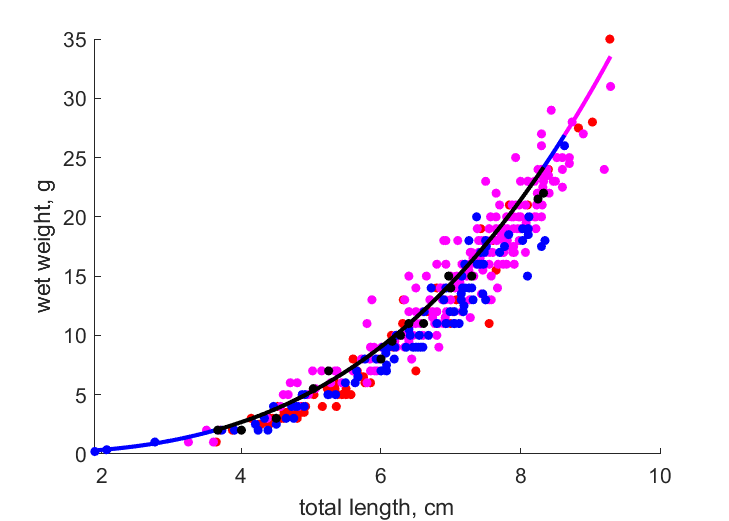 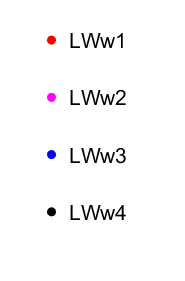 | total length | wet weight | (0.1507) | MaguKlob2011 |
| LWw2 |   | total length | wet weight | (0.1048) | MaguKlob2011 |
| LWw3 |   | total length | wet weight | (0.1593) | MaguKlob2011 |
| LWw4 |   | total length | wet weight | (0.07726) | MaguKlob2011 |
| LWw_m1 | 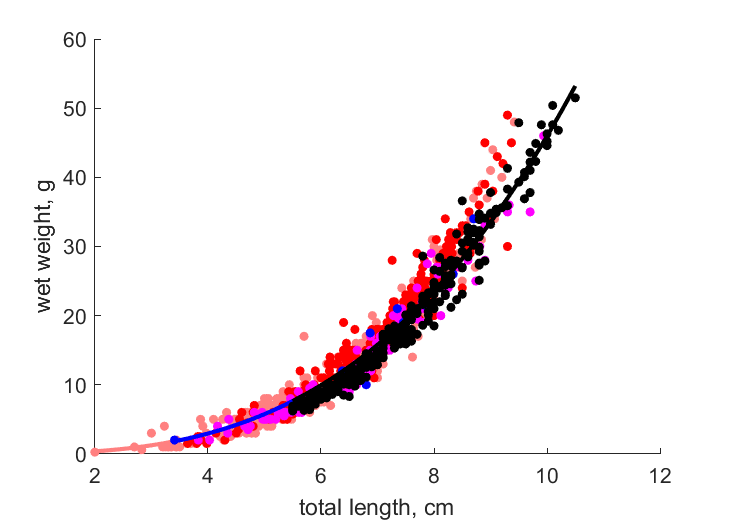 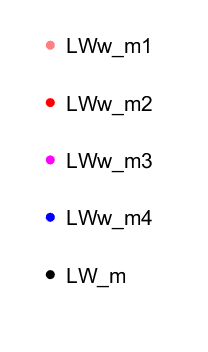 | total length | wet weight | (0.1428) | MaguKlob2011 |
| LWw_m2 |   | total length | wet weight | (0.1127) | MaguKlob2011 |
| LWw_m3 |   | total length | wet weight | (0.1055) | MaguKlob2011 |
| LWw_m4 |   | total length | wet weight | (0.1021) | MaguKlob2011 |
| LW_m |   | total length | wet weight | (0.08771) | BergStam2018 |
| LN1 | 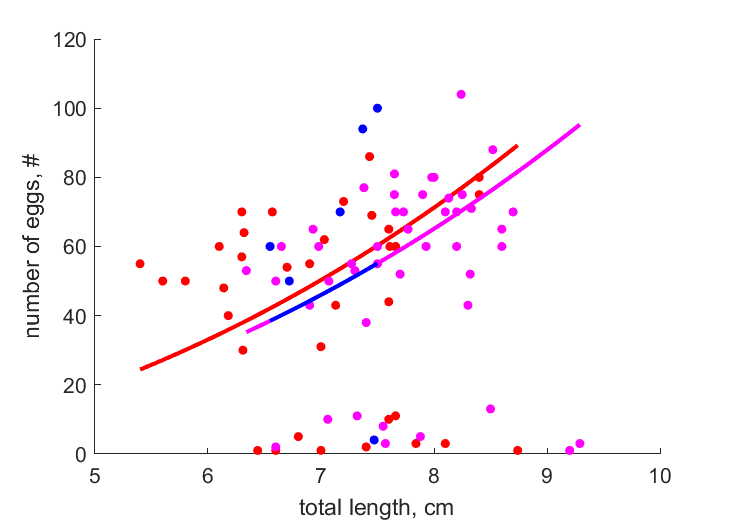  | total length | number of eggs | (0.6171) | MaguKlob2005 |
| LN2 |   | total length | number of eggs | (0.3916) | MaguKlob2005 |
| LN3 |   | total length | number of eggs | (0.4976) | MaguKlob2005 |
Pseudo-data at Tref = 20°C
| Data | Generalised animal | Austropotamobius torrentium | Unit | Description |
|---|---|---|---|---|
| v | 0.02 | 0.03048 | cm/d | energy conductance |
| p_M | 18 | 25.05 | J/d.cm^3 | vol-spec som maint |
| k_J | 0.002 | 0.002 | 1/d | maturity maint rate coefficient |
| k | 0.3 | 0.3547 | - | maintenance ratio |
| kap | 0.8 | 0.9491 | - | allocation fraction to soma |
| kap_G | 0.8 | 0.8006 | - | growth efficiency |
| kap_R | 0.95 | 0.95 | - | reproduction efficiency |
Discussion
- Males have larger claws than females, but females have a noticeably larger abdomen (Wiki); males and females differ in z and E_Hp
- Males are assumed to differ from females by {p_Am} only
Facts
- A freshwater crayfish species native to Central and Southeast Europe. Typical habitat are small fast streams with rocky (stone) bottom (esp in Croatia), but can be found in rivers and high altitude cold lakes. Summer water temperature optimum is between 14C and 18C, but can tolerate temperature between 8C and 23 C. (Ref: EoL)
- The stone crayfish \textit{Austropotamobius torrentium} (Schrank, 1803) is the smallest species of freshwater crayfish in the family Astacidae; Sexual dimorphism present between males and females (Ref: VlacVald2015, MaguMarn2017)
Bibliography